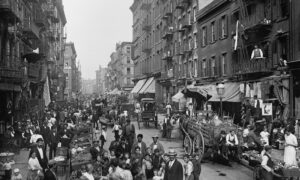How Americans Used to Eat

A colleague recently introduced me to a treasure trove of information about American eating habits in the 19th and early 20th centuries: The Buttolph Collection of Menus. Housed at the New York Public Library, the collection was a gift of Miss Frank E. Buttolph (1850-1924). The earliest menu dates from 1843, and contributions after Miss Buttolph’s death bring it up to the modern age. Of the more than 25,000 thousand menus, more than half are from New York restaurants, with most dating from 1890 to 1910.
The 1843 Breakfast Menu at Astor House in New York follows a pattern that continued until the later part of the century: “Soup,” “Fish,” “Boiled” [meats], “Side Dishes,” “Vegetables,” “Roast” [meats], “Game” [meats], “Pastry,” “Dessert.” All but the categories of vegetables, pastry, and desserts were seafoods and meats—lots of meat—beef, pork, chicken, lamb, goose, and snipe.
The side dishes to the main meat entree were also mostly meat—mutton, chicken pies, duck, small birds, and veal, some dressed in rich sauces—with macaroni and rice cakes “flavored with orange” as the only non-meat selections. After Vegetables come more meat selections under the Roast category: beef, lamb, pork, goose, and young chicken.
What jumps out are the organ meats: tongue, kidneys, jowl (written as “jole”), calf”s head with brain sauce (!), and “Harslets, sauté, Lyonnaise Style.” Harslet, according to the Collins Dictionary, means “a loaf of cooked minced pig’s offal (internal organs), eaten cold.”
The Soup of the day was clam soup and the seafoods interspersed throughout the menu were codfish with oyster sauce, oysters, barbecued bass, and lobsters.
Every early menu I looked at offered corned (salted) beef and many offered “cold pressed corned beef,” which seems to be a lot like Spam.
Missing from this breakfast menu are bacon and eggs—instead, the Astor House customers ate a meat-heavy breakfast. Patrons were probably served bread and butter but it is not noted on the menu. Nor are coffee and tea, but they were undoubtedly served.
Vegetable selections included mashed and boiled potatoes, rice, onions, beets, tomatoes, cabbage, green beans, squash, turnips, and “green corn.” Since the menu is dated August, these vegetables were probably all fresh, likely coming from New Jersey, the “Garden State,” on the train and then delivered by horse-drawn wagon.
Menus from the period consistently divided the dessert category into “Pastries” and “Dessert.” Pastries listed on the Astor House menu included pies (blackberry pie and cream pie), bread pudding, macaroons, “pommes merengue” and a strange dish called “broiled almonds,” about which I could find nothing on the Internet.
“Desserts” in all these early menus consisted of nuts (filberts, almonds, walnuts), raisins, fresh fruit (oranges, watermelons, cantaloupe, figs, peaches), and ice cream, in this case, “peach ice.”
By the way, breakfast service at the Astor House began at 5:30 a.m.—Americans got up early in those days!
Menus for the period 1851 through 1856 are all similar, whether in New York, Boston, or Hartford, Connecticut, all offering soup and fish courses, plenty of seafood and meat (“turkey and oysters” appears a couple of times), a variety of organ meats, a selection of vegetables, delicious-sounding pastries, and dessert of fresh fruit and nuts. Corned beef appears on every menu, in one case (The Revere House, Boston) served with dandelions. Hominy appears as another carbohydrate choice, along with potatoes and rice.
Organ meats include tongue, stewed calf’s head with Madeira sauce, calf’s feet in brown butter, calf’s liver in Madeira sauce, calf’s head in brain sauce (again), calf’s liver (larded, with sauce poivrade), kidneys, and tripe (the lining of beef, hog, or sheep stomach).
An 1887 menu from Toronto offers deer, wild turkey, and bear meat!
The 1853 breakfast menu on the U.S. Mail steamer Arctic from New York to Liverpool does offer eggs, prepared in many ways, plus many types of meat including bacon, cold meats, fresh and salted fish, sausages, calf’s liver, tripe, and kidneys. Carbohydrate offerings include rolls and bread, cornbread, potatoes, hominy, oatmeal, and mush (a thick porridge made with cornmeal).
Lettuce appears for the first time on an 1856 American House (Boston) menu, under “Relishes,” but it isn’t until the turn of the century that we begin seeing lettuce salads. Before that, a salad was a way of serving cold meat such as chicken, lobster, and shrimp, usually with a creamy dressing.
In 1856, Mart Ackerman’s Saloon in Toronto served steak with choice of fried onions, vegetables, or oyster sauce; mutton, lamb, pork, and chicken; trout, oysters prepared in several ways, pickled salmon, lobster, and sardines; pickled tripe; Welsh rarebit, mush and milk, scrambled eggs and egg omelet … all the better to work one’s way through a huge list of alcoholic beverages, including a whole page for champagne.
In 1900, the Cafeteria Lunch at 57 Broad Street, New York offered an array of seafood including oysters, clams, clam chowder, and cod fish balls with cream sauce, along with steaks, chops, eggs, ham, and the ubiquitous corned beef. You could also order vegetables (including a serving of celery), sandwiches, pies in season, and stewed prunes. But the best thing about the Cafeteria Lunch was that in addition to tea, cocoa, and “pure milk,” you could also order a glass of “1/2 cream” and even a glass of pure cream!
Americans did not only eat this way in restaurants. The 1895 Baptist Ladies Cookbook indicates that Americans were eating an abundance of meat, organ meats, seafood (especially oysters), and rich sauces in the home. Many of the vegetable recipes feature a cream sauce, and fried foods were cooked in lard. Americans ate salads featuring meat and seafood with cream-based dressings—only one salad in the book features lettuce, “when available.”
Lest you think that all this meat, cream, and rich sauces made people gain weight, have a look at old films of New York City, such as this one made in 1910 or this one from 1911. Not a single person in these films is overweight!
Fast forward to 1938. You could get a “lettuce” salad while dining on the Queen Mary, but also more substantial offerings such as foie gras, liver sausages, consomme, sheep’s head broth, calf’s liver and bacon, and rolled ox tongue.
Nutrient-dense foods were still on a 1941 menu from the Warner-Brothers Studio Café—a huge list of offerings crammed onto a single page. In addition to “modern” foods like salads, sandwiches, French fries (cooked in tallow), and hotdogs (but, oddly, no hamburgers), the menu offers actors and film crew members caviar, liver in many forms (pate de foie gras, goose liver, smoked liver sausage, chicken liver sandwich, chicken liver omelet), oysters raw and cooked in various ways, dozens of omelets, and many dishes featuring beef and lamb. Best of all, the menu lists “Certified Milk”—that would be raw milk—for 25 cents a glass. You could also order a glass of half and half.
This kind of wonderful eating did linger in smaller towns. A 1981 Bavarian House menu in Yorkville, Pennsylvania offered herring salad, herring in sour cream, consomme, head cheese, tongue salad, several choices of liver (liver dumpling soup, liver dumplings, and liver loaf), pig’s knuckle and kidney. Sadly, soft drinks are also on the menu, heralding the slippery slope to modern eating.
Back in the day, Americans ate nutrient-dense organ meats as well as copious amounts of meat and seafood—both at home and in restaurants. No longer. Very few Americans consume organ meats today, and even meat consumption has declined. While I am not saying that you have to eat calf’s head with brain sauce, these menus do offer us a guide for returning to real food.
Views expressed in this article are the opinions of the author and do not necessarily reflect the views of The Epoch Times. Epoch Health welcomes professional discussion and friendly debate. To submit an opinion piece, please follow these guidelines and submit through our form here.




